
PAVBLU 40 mg/ml INJECTABLE SOLUTION IN VIAL
Ask a doctor about a prescription for PAVBLU 40 mg/ml INJECTABLE SOLUTION IN VIAL

How to use PAVBLU 40 mg/ml INJECTABLE SOLUTION IN VIAL
Introduction
Package Leaflet: Information for the Patient
PAVBLU 40 mg/ml solution for injection in vial
aflibercept
This medicinal product is subject to additional monitoring, which will allow for quick identification of new safety information. You can help by reporting any side effects you may get. The last section of section 4 will tell you how to report side effects.
Read all of this leaflet carefully before you are given this medicine, because it contains important information for you.
- Keep this leaflet, you may need to read it again.
- If you have any further questions, ask your doctor.
- If you get any side effects, talk to your doctor, even if they are not listed in this leaflet. See section 4.
Contents of the pack
- What is PAVBLU and what is it used for
- What you need to know before you are given PAVBLU
- How PAVBLU will be given to you
- Possible side effects
- Storage of PAVBLU
- Contents of the pack and other information
1. What is PAVBLU and what is it used for
PAVBLU is a solution that is injected into the eye to treat certain eye diseases in adult patients, known as:
- neovascular (exudative) age-related macular degeneration, commonly known as wet AMD
- vision impairment due to macular edema following branch or central retinal vein occlusion (BRVO or CRVO)
- vision impairment due to diabetic macular edema (DME)
- vision impairment due to myopic choroidal neovascularization (myopic CNV)
Aflibercept, the active substance in PAVBLU, blocks the activity of a group of factors known as vascular endothelial growth factor A (VEGF-A) and placental growth factor (PlGF).
In patients with wet AMD and myopic CNV, when these factors are present in excess, they promote the formation of abnormal new blood vessels in the eye. These new blood vessels can cause leakage of blood components into the eye, resulting in damage to the eye tissues responsible for vision.
In patients with CRVO, there is a blockage of the main vein that carries blood from the retina. As a result, VEGF levels increase, causing fluid leakage in the retina and subsequent swelling of the macula (the part of the retina responsible for fine vision), known as macular edema. When the macula fills with fluid, central vision becomes blurred.
In patients with BRVO, there is a blockage of one or more branches of the main blood vessel that carries blood from the retina. As a result, VEGF levels increase, causing fluid leakage in the retina and subsequent swelling of the macula.
Diabetic macular edema is a swelling of the retina that occurs in patients with diabetes due to fluid leakage from the blood vessels in the macula. The macula is the part of the retina responsible for fine vision. When the macula swells with fluid, central vision becomes blurred.
PAVBLU has been shown to stop the growth of abnormal new blood vessels in the eye that often bleed or leak fluid. PAVBLU may help stabilize and, in many cases, improve vision loss caused by wet AMD, CRVO, BRVO, DME, and myopic CNV.
2. What you need to know before you are given PAVBLU
You should not be given PAVBLU
- if you are allergic to aflibercept or any of the other ingredients of this medicine (listed in section 6)
- if you have an active infection or suspect that you may have an infection in or around the eye (ocular or periocular infection)
- if you have severe inflammation of the eye (indicated by pain or redness)
Warnings and precautions
Talk to your doctor before you are given PAVBLU:
- If you have glaucoma.
- If you have a history of flashes of light or floaters or if you suddenly experience an increase in the size and number of floaters.
- If you have had or are scheduled to have eye surgery within the previous or next 4 weeks.
- If you have a severe form of CRVO or BRVO (ischemic CRVO or BRVO), treatment with PAVBLU is not recommended.
In addition, it is important that you know that:
- The safety and efficacy of PAVBLU when administered in both eyes at the same time have not been studied, and if used in this way, it may increase the risk of side effects.
- PAVBLU injections may cause an increase in pressure inside the eye (intraocular pressure) in some patients within 60 minutes after injection. Your doctor will monitor you after each injection.
- If you develop an infection or inflammation inside the eye (endophthalmitis) or other complications, you may notice pain or increased discomfort in the eye, worsening of redness, blurred or decreased vision, and increased sensitivity to light. It is essential that any symptoms that appear are diagnosed and treated as soon as possible.
- Your doctor will check if you have other risk factors that may increase the likelihood of a tear or detachment of the layers at the back of the eye (retinal tear or detachment, or retinal pigment epithelial tear or detachment), in which case PAVBLU will be administered with caution.
- PAVBLU should not be used during pregnancy, unless the potential benefit outweighs the potential risk to the fetus.
- Women of childbearing age should use effective contraceptive methods during treatment and for at least 3 months after the last injection of PAVBLU.
The systemic use of VEGF inhibitors, substances similar to those contained in PAVBLU, is potentially associated with the risk of blood clots blocking blood vessels (arterial thromboembolic events) that can lead to a heart attack or stroke. After injection of PAVBLU into the eye, there is a theoretical risk that these events may occur. Data on the safety of treatment in patients with CRVO, BRVO, DME, and myopic CNV who have had a stroke, transient ischemic attack, or myocardial infarction in the last 6 months are limited. If any of these apply to you, PAVBLU will be administered with caution.
Experience is limited in the treatment of:
- Patient with DME due to type 1 diabetes.
- Diabetic patients with very high average blood sugar levels (HbA1c above 12%).
- Diabetic patients with a diabetic eye disease known as proliferative diabetic retinopathy.
There is no experience in the treatment of:
- Patient with acute infections.
- Patient with other eye diseases such as retinal detachment or macular hole.
- Diabetic patients with uncontrolled hypertension.
- Non-Asian patients with myopic CNV.
- Patient who have been previously treated for myopic CNV.
- Patient with damage outside the central part of the macula (extrafoveal lesions) due to myopic CNV.
If any of the above applies to you, your doctor will take into account this lack of information when treating you with PAVBLU.
Children and adolescents
PAVBLU has not been studied in children and adolescents under 18 years of age, as wet AMD, CRVO, BRVO, DME, and myopic CNV mainly occur in adults. Therefore, its use in this age group is not recommended.
Using PAVBLU with other medicines
Tell your doctor if you are using, have recently used, or might use any other medicines.
Pregnancy and breastfeeding
- Women of childbearing age should use effective contraceptive methods during treatment and for at least 3 months after the last injection of PAVBLU.
- There is no experience with the use of PAVBLU in pregnant women. PAVBLU should not be used during pregnancy unless the potential benefit outweighs the potential risk to the fetus. If you are pregnant or plan to become pregnant, talk to your doctor before treatment with PAVBLU.
- Small amounts of PAVBLU may pass into breast milk. The effects on newborns/breastfed infants are unknown. PAVBLU is not recommended during breastfeeding. If you are breastfeeding, talk to your doctor before treatment with PAVBLU.
Driving and using machines
After injection of PAVBLU, you may experience temporary visual disturbances. Do not drive or use machines while these disturbances last.
PAVBLU contains
This medicine contains less than 1 mmol of sodium (23 mg) per dose unit, which is essentially "sodium-free".
This medicine contains 0.005 mg of polysorbate 80 in each 0.05 ml dose, equivalent to 0.1 mg/ml. Polysorbates may cause allergic reactions. Tell your doctor if you have any known allergies.
3. How PAVBLU will be given to you
PAVBLU will be given to you by a doctor with experience in giving eye injections, under aseptic conditions (clean and sterile).
The recommended dose is 2 mg of aflibercept (0.05 ml).
PAVBLU is given as an injection into the eye (intravitreal injection).
Before the injection, your doctor will use an antiseptic eye wash to carefully clean your eye to prevent infection. Your doctor will also give you a local anesthetic to reduce or prevent any pain you may feel with the injection.
Wet AMD
Patient with wet AMD will be treated with one injection per month for the first three doses, followed by another injection after 2 months.
Your doctor will then decide if the treatment interval between injections can be maintained every 2 months or gradually extended to 2 or 4 weeks if your disease has stabilized.
If your disease worsens, the interval between injections may be shortened.
You do not need to visit your doctor between injections unless your doctor considers it necessary or you experience any problems.
Macular edema secondary to branch or central retinal vein occlusion
Your doctor will determine the most suitable treatment schedule for you. Your treatment will start with a series of PAVBLU injections given once a month.
The interval between two injections should not be less than 1 month.
Your doctor may decide to discontinue treatment with PAVBLU if you do not benefit from continued treatment.
Treatment will continue with one injection per month until your disease has stabilized.
You may need 3 or more monthly injections.
Your doctor will monitor your response to treatment and may continue treatment, gradually increasing the interval between injections to stabilize your disease. If your disease worsens with a longer treatment interval, your doctor will reduce the interval between injections.
Based on your response to treatment, your doctor will decide on the follow-up and treatment schedule.
Diabetic macular edema (DME)
Patient with DME will be treated with one injection per month for the first 5 consecutive doses, and then one injection every 2 months.
The interval between treatments may be maintained every 2 months or adjusted according to your disease, based on the examination by your doctor. Your doctor will decide on the follow-up visit schedule.
Your doctor may decide to discontinue treatment with PAVBLU if you do not benefit from continued treatment.
Myopic choroidal neovascularization (myopic CNV)
Patient with myopic CNV will be treated with a single injection. You will only receive further injections if your doctor's examinations reveal that your disease has not improved.
The interval between two injections should not be less than 1 month.
If your disease disappears and then recurs, your doctor may restart treatment.
Your doctor will decide on the follow-up schedule.
If you miss an injection of PAVBLU
Make a new appointment to be examined and given the injection.
Stopping treatment with PAVBLU
Talk to your doctor before stopping treatment.
If you have any further questions on the use of this medicine, ask your doctor.
4. Possible side effects
Like all medicines, this medicine can cause side effects, although not everybody gets them.
Potentially, allergic reactions(hypersensitivity) may occur. These can be serious and require you to contact your doctor immediately.
With the administration of PAVBLU, some side effects may occur that affect the eyes and are due to the injection procedure. Some can be serious, including blindness, a severe infection or inflammation inside the eye(endophthalmitis), detachment, tear, or hemorrhage of the light-sensitive layer at the back of the eye(retinal detachment, retinal tear), clouding of the lens(cataract), bleeding in the eye(vitreous hemorrhage), detachment of the gel-like substance inside the eye from the retina(vitreous detachment), and increased pressure inside the eye(see section 2). These serious eye side effects occurred in less than 1 in 1,900 injections during clinical trials.
If you notice a sudden decrease in vision or an increase in pain and redness in the eye after injection, contact your doctor immediately.
List of reported side effects
The following is a list of side effects reported as possibly related to the injection procedure or the medicine. Do not be alarmed, as you may not experience any of them. Always talk to your doctor about any suspected side effect.
Very common side effects(may affect more than 1 in 10 people):
- visual impairment
- bleeding in the back of the eye (retinal hemorrhage)
- blood in the eye due to bleeding from small blood vessels in the outer layers of the eye
- eye pain
Common side effects(may affect up to 1 in 10 people):
- detachment or tear of one of the layers at the back of the eye that produce flashes of light with floaters that may progress to vision loss (retinal pigment epithelial tear or detachment, retinal tear or detachment)
- retinal degeneration (causing vision disturbances)
- bleeding in the eye (vitreous hemorrhage)
- certain types of clouding of the lens (cataract)
- damage to the outer layer of the eyeball (cornea)
- increased pressure inside the eye
- floaters in the vision
- detachment of the gel-like substance inside the eye from the retina (vitreous detachment, resulting in flashes of light with floaters)
- sensation of having something in the eye
- increased tear production
- swelling of the eyelid
- bleeding at the injection site
- redness of the eye
*Side effects known to be associated with wet AMD; observed only in patients with wet AMD.
Uncommon side effects(may affect up to 1 in 100 people):
- allergic reactions (hypersensitivity)**
- inflammation or severe infection inside the eye (endophthalmitis)
- inflammation of the iris or other parts of the eye (iritis, uveitis, iridocyclitis, cells in the anterior chamber)
- abnormal sensation in the eye
- irritation of the eyelid
- swelling of the outer layer of the eyeball (cornea)
**Allergic reactions were reported as rash, itching (pruritus), hives (urticaria), and some cases of severe allergic reactions (anaphylactic/anaphylactoid reactions).
Rare side effects(may affect up to 1 in 1,000 people):
- blindness
- clouding of the lens due to injury (traumatic cataract)
- inflammation of the gel-like substance inside the eye
- pus in the eye
Frequency not known(cannot be estimated from the available data):
- inflammation of the white part of the eye associated with redness and pain (scleritis)
In clinical trials, an increased incidence of bleeding from small blood vessels in the outer layers of the eye (conjunctival hemorrhage) was observed in patients with wet AMD receiving anticoagulant therapy. This increased incidence was comparable in patients treated with ranibizumab and aflibercept.
The systemic use of VEGF inhibitors, substances similar to those contained in PAVBLU, is potentially associated with the risk of blood clots blocking blood vessels (arterial thromboembolic events) that can lead to a heart attack or stroke. After injection of PAVBLU into the eye, there is a theoretical risk that these events may occur.
As with all therapeutic proteins, there is a possibility of an immune reaction (formation of antibodies) with PAVBLU.
Reporting of side effects
If you experience any side effects, talk to your doctor, even if they are not listed in this leaflet. You can also report side effects directly through the national reporting system listed in Appendix V. By reporting side effects, you can help provide more information on the safety of this medicine.
5. Storage of PAVBLU
- Keep this medicine out of the sight and reach of children.
- Do not use this medicine after the expiry date which is stated on the carton and label after “EXP”. The expiry date refers to the last day of the month.
- Store in a refrigerator (between 2 °C and 8 °C). Do not freeze.
- The unopened blister in the outer packaging may be stored outside the refrigerator for a maximum of 30 °C for a maximum of 3 days.
- Store in the original packaging to protect from light.
- Medicines should not be disposed of via wastewater or household waste. Ask your pharmacist how to dispose of medicines no longer required. This will help protect the environment.
6. Package contents and additional information
Composition of PAVBLU
- The active substance is: aflibercept. One vial contains an extractable volume of at least 0.1 ml, equivalent to at least 4 mg of aflibercept. One vial provides a dose of 2 mg of aflibercept in 0.05 ml.
- The other ingredients are: polysorbate 80, sucrose, α,α-trehalose dihydrate, water for injections.
See “PAVBLU contains” in section 2 for more information.
Appearance and package contents of the product
PAVBLU is an injectable solution (injectable) in a vial. The solution is clear to opalescent, colorless to slightly yellow.
Package with 1 vial
Marketing authorization holder and manufacturer
Amgen Technology (Ireland) UC
Pottery Road, Dun Laoghaire
Co. Dublin,
A96 F2A8
Ireland
Marketing authorization holder
Amgen Technology (Ireland) UC
Pottery Road, Dun Laoghaire
Co. Dublin,
A96 F2A8
Ireland
Manufacturer
Amgen NV
Telecomlaan 5-7
1831 Diegem
Belgium
For further information about this medicine, please contact the local representative of the marketing authorization holder:
België/Belgique/Belgien s.a. Amgen n.v. Tél/Tel: +32 (0)2 7752711 | Lietuva Amgen Switzerland AG Vilniaus filialas Tel.: +370 5 219 7474 |
| Luxembourg/Luxemburg s.a. Amgen Belgique/Belgien Tél/Tel: +32 (0)2 7752711 |
Ceská republika Amgen s.r.o. Tel: +420 221 773 500 | Magyarország Amgen Kft. Tel.: +36 1 35 44 700 |
Danmark Amgen, filial af Amgen AB, Sverige Tlf: +45 39617500 | Malta Amgen S.r.l. Italy Tel: +39 02 6241121 |
Deutschland Amgen GmbH Tel.: +49 89 1490960 | Nederland Amgen B.V. Tel: +31 (0)76 5732500 |
Eesti Amgen Switzerland AG Vilniaus filialas Tel: +372 586 09553 | Norge Amgen AB Tlf: +47 23308000 |
Ελλάδα Amgen Ελλάς Φαρμακευτική Ε.Π.Ε. Τηλ: +30 210 3447000 | Österreich Amgen GmbH Tel: +43 (0)1 50 217 |
España Amgen S.A. Tel: +34 93 600 18 60 | Polska Amgen Biotechnologia Sp. z o.o. Tel.: +48 22 581 3000 |
France Amgen S.A.S. Tél: +33 (0)9 69 363 363 | Portugal Amgen Biofarmacêutica, Lda. Tel: +351 21 4220606 |
Hrvatska Amgen d.o.o. Tel: +385 (0)1 562 57 20 | România Amgen România SRL Tel: +4021 527 3000 |
Ireland Amgen Ireland Limited Tel: +353 1 8527400 | Slovenija AMGEN zdravila d.o.o. Tel: +386 (0)1 585 1767 |
Ísland Vistor hf. Sími: +354 535 7000 | Slovenská republika Amgen Slovakia s.r.o. Tel: +421 2 321 114 49 |
Italia Amgen S.r.l. Tel: +39 02 6241121 | Suomi/Finland Amgen AB, sivuliike Suomessa/Amgen AB, filial i Finland Puh/Tel: +358 (0)9 54900500 |
Kύπρος C.A. Papaellinas Ltd Τηλ: +357 22741 741 | Sverige Amgen AB Tel: +46 (0)8 6951100 |
Latvija Amgen Switzerland AG Rigas filiale Tel: +371 257 25888 |
Date of last revision of this leaflet:
Other sources of information
Detailed information on this medicine is available on the European Medicines Agency website: https://www.ema.europa.eu.
-----------------------------------------------------------------------------------------------------------------
This information is intended for healthcare professionals only:
The vial should be used for the treatment of a single eye.
The vial contains more than the recommended dose of 2 mg of aflibercept (equivalent to 0.05 ml). The excess volume should be discarded before administration.
Before administration, the solution should be visually inspected for the presence of particles and/or a change in color or any change in physical appearance. If any of these are observed, do not use the medicine. Do not use if the packaging is open or damaged.
The unopened vial of PAVBLU may be stored outside the refrigerator for a maximum of 30 °C for a maximum of 3 days. After opening the vial, proceed under aseptic conditions.
For intravitreal injection, a 30 G × ½ inch (1.27 cm) injection needle should be used.
Instructions for use of the vial:
- Remove the plastic cap and disinfect the external part of the rubber stopper of the vial.
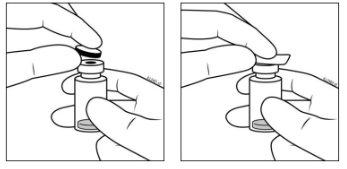
- Attach the 5-micron filter needle to a sterile 1-ml syringe with a Luer-Lock adapter.
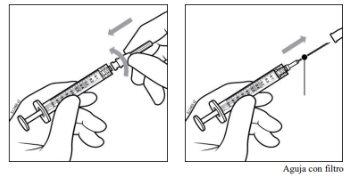
Note:When ready to extract PAVBLU, remove the plastic protection from the needle and place it in a container for sharp objects.
- Push the filter needle through the center of the vial stopper until the needle is fully inserted into the vial and its end comes into contact with the bottom or the lower internal edge of the vial.
- Using an aseptic technique, transfer the entire contents of the PAVBLU vial to the syringe, keeping the vial in a vertical position and slightly tilted to facilitate complete extraction. To avoid introducing air, ensure that the bevel of the filter needle is submerged in the solution. Continue tilting the vial during extraction, keeping the bevel of the filter needle submerged in the solution.
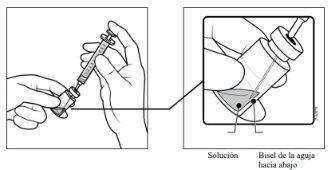
- Ensure that the plunger rod is sufficiently withdrawn when emptying the vial to completely empty the filter needle.
- Remove the filter needle and discard it properly.
Note: The filter needle should not be used for intravitreal injection.
- Using an aseptic technique, firmly attach a 30 G × ½ inch (1.27 cm) injection needle to the tip of the syringe with the Luer-Lock adapter, making a rotational movement.
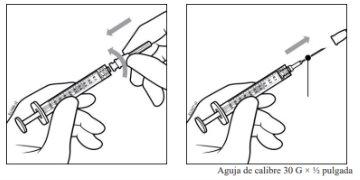
Note:When ready to administer PAVBLU, remove the plastic protection from the needle and place it in a container for sharp objects.
- Keep the syringe with the needle pointing upwards and check that there are no bubbles inside. If there are, gently tap the syringe with your finger until they rise to the top.
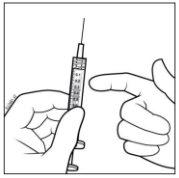
- Eliminate all bubbles and expel excess medication by slowly pushing the plunger so that the flat edge of the plunger aligns with the line indicating 0.05 ml on the syringe.

- The vial is for single use. Extracting multiple doses from a single vial may increase the risk of contamination and subsequent infection.
The disposal of unused medicine and all materials that have come into contact with it will be carried out in accordance with local regulations.
- Country of registration
- Active substance
- Prescription requiredYes
- Manufacturer
- This information is for reference only and does not constitute medical advice. Always consult a licensed doctor before taking any medication. Oladoctor is not responsible for medical decisions based on this content.
- Alternatives to PAVBLU 40 mg/ml INJECTABLE SOLUTION IN VIALDosage form: INJECTABLE, 40 mg/mlActive substance: afliberceptManufacturer: Sandoz GmbhPrescription requiredDosage form: INJECTABLE, 40 mg/mlActive substance: afliberceptManufacturer: Sandoz GmbhPrescription requiredDosage form: INJECTABLE, 40 mg/mlActive substance: afliberceptManufacturer: Celltrion Healthcare Hungary Kft.Prescription required
Alternatives to PAVBLU 40 mg/ml INJECTABLE SOLUTION IN VIAL in other countries
The best alternatives with the same active ingredient and therapeutic effect.
Alternative to PAVBLU 40 mg/ml INJECTABLE SOLUTION IN VIAL in Ukraine
Online doctors for PAVBLU 40 mg/ml INJECTABLE SOLUTION IN VIAL
Discuss dosage, side effects, interactions, contraindications, and prescription renewal for PAVBLU 40 mg/ml INJECTABLE SOLUTION IN VIAL – subject to medical assessment and local rules.















